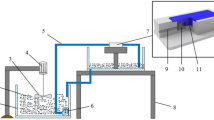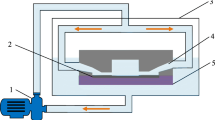Abstract
To resolve the low-polishing efficiency problem caused by the turbulent layer separation in soft abrasive flow (SAF) processing, an ultrasonic-assisted SAF (UA-SAF) method is proposed based on the vibration effect. The coupled computational fluid dynamics (CFD)-discrete element method (DEM) modeling method (CFD-DEM) and the dynamic mesh are used to represent the UA-SAF flow and the periodic moving boundary caused by ultrasonic vibration, while the particle-wall erosion is calculated by the Archard model. Through tracking the abrasive particle motion in the simulation, the particle-wall collision states and the particle cutting effect are revealed, which mainly includes the particle plowing and the particle impact erosion. It has been found from the simulation that the fluid turbulent motion and the fluid dynamic pressure which are the power source for the particles to obtain the anisotropic cutting kinetic energy can be strengthened obviously by the ultrasonic vibrating, which results in the increase of the probability of particle impacting the target surface, and then the particle-wall wear rate and the wear area can be improved. A set of comparative experiments, including the rough and precision polishing procedures, are then conducted to evaluate the polishing performance by using the SAF and UA-SAF, respectively. The variations of the surface roughness and the workpiece mass are obtained, and the surface morphologies are observed. The experimental results prove that the ultrasonic vibration can effectively improve the abrasive flow polishing efficiency and precision without producing cavitation erosion.





















Similar content being viewed by others
Data availability
All data generated or analyzed during this study are included in this published article.
References
Chen B, Li SC, Deng ZH, Guo B, Zhao QL (2017) Grinding marks on ultra-precision grinding spherical and aspheric surfaces. Int J Precis Eng Manuf-Green Technol 4(4):419–429
Beaucamp A, Namba Y (2013) Super-smooth finishing of diamond turned hard X-ray molding dies by combined fluid jet and bonnet polishing. Cirp Ann-Manuf Technol 62(1):315–318
Li HN, Wang JP, Wu CQ, Zhao YJ, Xu J, Liu XL, Zhu WQ (2020) Damage behaviors of unidirectional CFRP in orthogonal cutting: a comparison between single- and multiple-pass strategies. Compos B Eng 185:107774
Chen XY, Gu Y, Lin JQ, Yi A, Kang MS, Cang XY (2020) Study on subsurface damage and surface quality of silicon carbide ceramic induced by a novel non-resonant vibration-assisted roll-type polishing. J Mater Process Technol 282:116667
Chen ZZ, Qi H, Zhao B, Zhou Y, Shi LW, Li HN, Ding WF (2021) On the tribology and grinding performance of graphene-modified porous composite-bonded CBN wheel. Ceram Int 47(3):3259–3266
Xie Y, Gui FX, Wang WJ (2021) An adaptive decoding biased random key genetic algorithm for cloud workflow scheduling. Appl Sci 11 (in press)
Li M, Lyu BH, Yuan JL, Dong CC, Dai WT (2015) Shear-thickening polishing method. Int J Mach Tool Manu 94:88–89
Zhao J, Huang JF, Wang R, Peng HR, Hang W, Ji SM (2020) Investigation of the optimal parameters for the surface finish of K9 optical glass using a soft abrasive rotary flow polishing process. J Manuf Process 49:26–34
Jain VK, Adsul G (2000) Experimental investigations into abrasive flow machining (AFM). Int J Mach Tool Manu 40:1003–1021
Das M, Jain VK, Ghoshdastidar PS (2008) Fluid flow analysis of magnetorheological abrasive flow finishing (MRAFF) process. Int J Mach Tool Manu 48(3–4):415–426
Kanaoka M, Takino H, Nomura K, Mori Y, Mimura H, Yamauchi K (2007) Removal properties of low-thermal-expansion materials with rotating-sphere elastic emission machining. Sci Technol Adv Mat 8(3):170–172
Ge JQ, Li C, Gao ZY, Ren YL, Xu XS, Li C, Xie Y (2021) Softness abrasive flow polishing method using constrained boundary vibration. Powder Technol 382:173–187
Wang T, Cheng HB, Chen Y, Tam H (2014) Multiplex path for magnetorheological jet polishing with vertical impinging. Appl Opt 53(10):2012–2019
Qi H, Qin SK, Cheng ZC, Teng Q, Hong T, Xie Y (2021) Towards understanding performance enhancing mechanism of micro-holes on K9 glasses using ultrasonic vibration-assisted abrasive slurry jet. J Manuf Process (Article in Press)
Li C, Ji SM, Tan DP (2012) Softness abrasive flow method oriented to tiny scale mold structural surface. Int J Adv Manuf Technol 61(9–12):975–987
Ji SM, Xiao FQ, Tan DP (2010) Analytical method for softness abrasive flow field based on discrete phase model. Sci China-Technol Sci 53(10):2867–2877
Li C, Xu QD, Ge JQ, Li ZA, Guo LM (2020) Study of soft abrasive flow field measurement based on particle image velocimetry. Int J Adv Manuf Technol 109(7–8):2039–2047
Tan DP, Ji SM, Fu YZ (2016) An improved soft abrasive flow finishing method based on fluid collision theory. Int J Adv Manuf Technol 85(5–8):1261–1274
Zhang L, Yuan ZM, Qi ZJ, Cai DH, Cheng ZC, Qi H (2018) CFD-based study of the abrasive flow characteristics within constrained flow passage in polishing of complex titanium alloy surfaces. Powder Technol 333:209–218
Ge JQ, Ji SM, Tan DP (2018) A gas-liquid-solid three-phase abrasive flow processing method based on bubble collapsing. Int J Adv Manuf Technol 95(1–4):1069–1085
Wu J, Qin N, Bao DH (2018) Effective enhancement of piezocatalytic activity of BaTiO3 nanowires under ultrasonic vibration. Nano Energy 45:44–51
Cheng WP, Li CC, Yu RF (2008) Preparing polyaluminum chloride coagulants using ultrasonic-assisted NaOH dosing. Environ Eng Sci 25(3):451–459
Li HN, Zhao Y, Cao S, Chen H, Qi H, Sun X, Li C, Liu G (2021) Controllable generation of 3D textured abrasive tools via multiple-pass laser ablation: parameter effects and selection. J Mater Process Technol (Article in Press). https://doi.org/10.1016/j.jmatprotec.2021.117050
Qi H, Qin SK, Cheng ZC, Zou YL, Cai DH, Wen DH (2021) DEM and experimental study on the ultrasonic vibration-assisted abrasive finishing of WC-8Co cemented carbide cutting edge. Powder Technol 378:716–723
Yuan QL, Qi H, Wen DH (2016) Numerical and experimental study on the spiral-rotating abrasive flow in polishing of the internal surface of 6061 aluminium alloy cylinder. Powder Technol 302:153–159
Girardi M, Radl S, Sundaresan S (2016) Simulating wet gas-solid fluidized beds using coarse-grid CFD-DEM. Chem Eng Sci 144:224–238
Zeng DZ, Zhang EB, Ding YY, Yi YG, Xian QB, Yao GJ, Zhu HJ, Shi TH (2018) Investigation of erosion behaviors of sulfur-particle-laden gas flow in an elbow via a CFD-DEM coupling method. Powder Technol 329:115–128
Chen JK, Wang YS, Li XF, He RY, Han S, Chen YL (2015) Erosion prediction of liquid-particle two-phase flow in pipeline elbows via CFD–DEM coupling method. Powder Technol 275:182–187
Morsi S, Alexander AJ (1972) An investigation of particle trajectories in two-phase flow systems. J Fluid Mech 55:193–208
Ebrahimi M, Crapper M, Ooi JY (2014) Experimental and simulation studies of dilute horizontal pneumatic conveying. Part Sci Technol 32(2):206–213
Blais B, Bertrand F (2017) CFD-DEM investigation of viscous solid–liquid mixing: impact of particle properties and mixer characteristics. Chem Eng Res Des 118:270–285
Saffman PG (1965) The lift on a small sphere in slow shear flow. J Fluid Mech 22:385–400
Mei R (1992) An approximate expression for the shear lift force on a spherical particle at finite Reynolds number. Int J Multiphase Flow 18(1):145–147
Cunez FD, Franklin E (2019) Plug regime in water fluidized beds in very narrow tubes. Powder Technol 345:234–246
Archard J (1953) Contact and rubbing of flat surfaces. J Appl Phys 24(8):981–988
Li WH, Li XH, Yang SQ, Li WD (2018) A newly developed media for magnetic abrasive finishing process: material removal behavior and finishing performance. J Mater Process Technol 260:20–29
Brandao JA, Cerqueira P, Seabra JHO, Castro MJD (2016) Measurement of mean wear coefficient during gear tests under various operating conditions. Tribol Int 102:61–69
Wu C, Cao S, Zhao YJ, Qi H, Liu X, Liu G, Guo J, Li HN (2021) Preheating assisted wire EDM of semi-conductive CFRPs: principle and anisotropy. J Mater Process Technol 288:116915
Chung KH, Lee YH, Kim DE (2005) Characteristics of fracture during the approach process and wear mechanism of a silicon AFM tip. Ultramicroscopy 102(2):161–171
Zbib H, Ebrahimi M, Ein-Mozaffari F, Lohi A (2018) Comprehensive analysis of fluid-particle and particle-particle interactions in a liquid-solid fluidized bed via CFD-DEM coupling and tomography. Powder Technol 340:116–130
Funding
This research was funded by the National Natural Science Foundation of China (No. 51905515), China Postdoctoral Science Foundation (No. 2020M671709), 2019 Active Design Projects of Key R&D Plans of Zhejiang Province (No. 2019C01128), 2019 Projects on Public Welfare Technology Research of Zhejiang Province (No. LGF19G030004), and Major Projects of the National Social Science Funds (No. 18ZDA079).
Author information
Authors and Affiliations
Corresponding author
Ethics declarations
Conflict of interest
The authors declare that they have no conflicts of interest.
Ethics approval
Not applicable.
Consent to participate
Not applicable.
Consent for publication
Not applicable.
Additional information
Publisher’s note
Springer Nature remains neutral with regard to jurisdictional claims in published maps and institutional affiliations.
Rights and permissions
About this article
Cite this article
Ge, Jq., Ren, Yl., Xu, Xs. et al. Numerical and experimental study on the ultrasonic-assisted soft abrasive flow polishing characteristics. Int J Adv Manuf Technol 112, 3215–3233 (2021). https://doi.org/10.1007/s00170-021-06598-2
Received:
Accepted:
Published:
Issue Date:
DOI: https://doi.org/10.1007/s00170-021-06598-2




